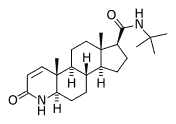An experimental drug can help relieve urinary problems caused by a swollen prostate gland, a new study indicates. If proved safe, the drug may one day replace surgery as the standard treatment for the more serious stages of this condition, which to some degree afflicts most men aged 50 and older.
The normally walnut-sized prostate gland, just below the bladder, tends to swell as men grow older. If the enlarged gland compresses the urethra, it can restrict the flow of urine -- and in some cases eventually shut down urination. Standard treatment for advanced cases involves surgically trimming the enlarged gland -- a costly procedure that causes impotence in some cases.
But the new drug, finasteride, appears to provide an alternative to surgery, according to results from a year-long, placebo-controlled drug trial involving 1,645 men suffering from an enlarged prostate. The study, reported in Toronto this week at an American Urological Association meeting, showed finasteride reduced prostated size by at least 20 percent in most of the 550 men who received the higher of two experimental dosages -- 5 milligrams daily.
"Our clinical data suggest that finasteride can halt progression of the disease," says Elizabeth Stoner, a researcher at Merck Sharp & Dohme, the pharmaceutical firm that developed finasteride. Stoner presented her team's data, compiled by 76 centers in North America, Australia, New Zealand and Europe.
In most men, an enlarged prostate will cause urinary symptoms to worsen over time. But after one year on finasteride, 57 percent of the treated men reported a "modest" improvement in urine flow. This suggests the drug helps reverse progressive enlargement of the prostate, Stoner says. The 550 men receiving daily placebo pills reported no such relief from urinary troubles.
Stoner's team suspects finasteride works by inhibiting an enzyme (5-alpha reductase) that converts the male hormone testosterone to dihydrotestoster-one, a substance that fuels the growth of the prostate.
Finasteride "holds promise" as a new treatment for enlarged prostates, says H. Logan Holtgrewe, a urologist at Johns Hopkins University in Baltimore. However, he cautions, to sustain its effects, men would have to take the drug for the rest of their lives. Though Stoner agrees, she notes that the trial revealed just a few, mild side effects, including general weakness. Merck plans to study finasteride's long-term safely and efficacy in another trial, she adds.
COPYRIGHT 1991 Science Service, Inc.
COPYRIGHT 2004 Gale Group



